Internationalisation of curriculum at home: Imperatives, opportunities and challenges for allied health education
DOI:
https://doi.org/10.21153/jtlge2015vol6no1art575Keywords:
allied health, health graduates, Internationalisation of Curriculum, Internationalisation at Home, internationalisation of higher education, global health, cross-cultural communicationAbstract
Preparation of globally competent health graduates who have a good understanding of local and international healthcare is an important goal for allied health education. Internationalisation of curriculum and Internationalisation at home strategies are needed to prepare students to work in culturally diverse contexts. A critical review of issues, challenges and future needs in internationalisation of allied health curricula is the focus of this paper. Current approaches to internationalisation from a range of disciplines are considered and their applicability to allied health courses is discussed. Important challenges for progress on internationalisation goals and integration of internationalisation experiences into allied health curricula are identified. Suggestions for progressing internationalisation of allied health curricula through formal and informal curriculum are presented. Future research needs that are key to progressing internationalisation goals in allied health education are considered. Important questions that will prompt academic, clinical educators and students to consider how well internationalisation goals are being addressed in allied health education are also raised.
Metrics
References
Adelman, C. (2004). Principal indicators of student academic histories in postsecondary education 1972-2000. Washington, DC: US Department of Education.
APTA (2014). The role of the physical therapist in national health care reform. Retrieved June 14, 2014, from http://www.apta.org/search.aspx?q=The%20Role%20of%20the%20Physical%20Therapist %20in%20National%20Health%20Care%20Rform
Bell, M. (2008). Internationalising the Australian higher education curriculum through global learning. Paper presented at the HERDSA 2008 Conference, Rotorua, New Zealand.
Boeker, M., Vach, W., & Motschall, E. (2013). Google Scholar as replacement for systematic literature searches: Good relative recall and precision not enough. BMC Medical Research Methodology, 13(131), 1–12.
Caballero, C., Walker, A., & Fuller-Tyszkiewicz, M. (2011). The work readiness scale (WRS): Developing a measure to assess work readiness in college graduates. Journal of Teaching and Learning for Graduate Employability, 2(2), 41–54.
Calvillo, E., Clark, L., Ballantyne, J. E., Pacquiao, D., Purnell, L. D., & Villarruel, A. M. (2009). Cultural competency in Baccalaureate nursing education. Journal of Transcultural Nursing, 20(2), 137–145.
Chipchase, L., Allen, S., Eley, D., McAllister, L., & Strong, J. (2012). Interprofessional supervision in an intercultural context: A qualitative study. Journal of Interprofessional Care, 26(6), 465–471.
Cobbin, P. E., & Lee, R. E. N., (2002). A micro-journal approach to internationalising the accounting curriculum. Journal of Studies in International Education, 6(1), 59–77.
Crosling, G., Edwards, R., & Schroder, B. (2008). Internationalizing the curriculum: The implementation experience in a faculty of business and economics. Journal of Higher Education Policy and Management, 30(2), 107–121.
Das, R. (2005). Internationalisation of the curriculum: Putting theory into practice in a physiotherapy program. Journal of University Teaching & Learning Practice, 2(1), 25–35.
Davies, I., & Shirley, M. (2007). Internationalising work-integrated learning for law students. Paper presented at the 15th World Conference on Cooperative Education (WACE), Singapore.
Deardorff, D.K. (2006). The identification and assessment of intercultural competence. Journal of Studies in International Education, 10(3), 241–266.
Deardorff, D., Thorndike Pysarchik, D., & Yun, Z.S. (2009). Towards effective international learning assessment: Principles, design and implementation. In H. De Wit (Ed.), Measuring success in the internationalisation of higher education (pp.23–38). European Association for International Education (EAIE), EAIE Occasional Paper no. 22.
De Wit, H. (2009). Measuring success in the internationalisation of higher education: An introduction. In H. De Wit (Ed.), Measuring success in the internationalisation of higher education (pp.1–8). European Association for International Education (EAIE), EAIE Occasional Paper no. 22.
De Wit, H. (2011). Internationalization misconceptions. International Higher Education, 64, 6–7.
De Wit (2012). Internationalisation of higher education: Nine misconceptions. In J. Beelen & H. De Wit (Eds.), Internationalisation revisited: New dimensions in the internationalisation of higher education (pp.5–8).Centre for applied research on economics and management (CAREM), Amsterdam University of Applied Sciences, The Netherlands. Retrieved on December 3, 2015, from http://kennisbank.hva.nl/document/497769
Evans, E., Tindale, J., Cable, D., & Hamil Mead, S. (2009). Collaborative teaching in a linguistically and culturally diverse higher education setting: A case study of a postgraduate accounting program. Higher Education Research & Development, 28(6), 597–613.
Fuller, T., & Scott, G. (2009). Employable global graduates: The 'edge' that makes the difference. Proceedings of the 18th Annual Teaching Learning Forum, 29-30 January 2009, Perth: Curtin University of Technology. Retrieved on October 18, 2010, from http://otl.curtin.edu.au/tlf/tlf2009/refereed/fuller.html
Garfinkle, A. (2007). Metro international: Creating local connections with the New York City community. In H. Teekens (Ed.), Internationalisation at home: Ideas and ideals (pp. 69–72). European Association for International Education, EAIE Occasional Paper no. 20.
Gray, J.E., Hamilton, M.C., Hauser, A., Janz, M.M., Peters, J.P., & Taggart, F. (2012). Scholarish Google Scholar and its value to the sciences. Issues in Science and Technology Librarianship, Summer 2012. doi: 10.5062/F4MK69T9.
Hafferty, F. (1998). Beyond curriculum reform: Confronting medicine's hidden curriculum. Academic Medicine, 73(4), 403–407.
Hall, D. (2010). Internationalisation of the curriculum: Comparison and evaluation of definitions. Retrieved September 13, 2013, from http://www.google.com.au/url?sa=t&rct=j&q=&esrc=s&frm=1&source=web&cd=2&cad=rja& uact=8&ved=0CCQQFjAB&url=http%3A%2F%2Ftne.curtin.edu.au%2Flocal%2Fdocuments %2Fdefinitions_internationalisation.pdf&ei=UQrfU4XbH87k8AWXzILIBg&usg=AFQjCNEXf XerT32GsGtDAgSlGRE3Rl_RJw
Hanover Research Council Report. (2010). Internationalization of the curriculum in higher education. Retrieved September 10, 2013, from http://www.google.com.au/url?sa=t&rct=j&q=&esrc=s&frm=1&source=web&cd=1&cad=rja& uact=8&ved=0CBwQFjAA&url=http%3A%2F%2Fwww.hu.ac.th%2Fenglish%2Facademic% 2Fdocuments%2FInternationalization%2520of%2520the%2520Curriculum%2520in%2520 Higher%2520Education%2520%2520Membership.pdf&ei=6B7bU4zNIJe68gWg54CgDg&u sg=AFQjCNHWJ01_lsSaiZo2KnjVL9NB2HIdLA
Harden, R.M. (2006). International medical education and future directions: A global perspective. Academic Medicine, 81(12 Supplement), 22–29.
Ho, E., Holmes, P., & Cooper, J. (2004). Review and evaluation of international literature on managing cultural diversity in the classroom. Wellington: Ministry of Education and Education New Zealand.
Horton, A. (2009). Internationalising occupational therapy education. The British Journal of Occupational Therapy, 72, 227–230.
Hudzik, J.K., & Stohl, M. (2009). Modelling assessment of the outcomes and impacts of internationalisation. In H. De Wit (Ed.), Measuring success in the internationalisation of higher education (pp.9-22). European Association for International Education, EAIE Occasional Paper no. 22.
Jenkins-Deas, B. (2009). The impact of quality review on the internationalisation of Malsapina University-College, Canada: A case study. In H. De Wit (Ed.), Measuring success in the internationalisation of higher education (pp.109-121). European Association for International Education, EAIE Occasional Paper no. 22.
Jones, E., & De Wit, H. (2012). Globalization of internationalization: Thematic and regional reflections on a traditional concept. The International Journal of Higher Education and Democracy, 3, 35–54.
Kinsella, E. A., Bossers, A., & Ferreira, D. (2008). Enablers and challenges to international practice education: A case study. Learning in Health and Social Care, 7(2), 79–92.
Knight, J. (2003). Updated internationalization definition. International Higher Education, 33, 2– 3.
Knight, J. (2004). Internationalization remodeled: Definition, approaches, and rationales. Journal of Studies in International Education, 8(1), 5–31.
Knight, J. (2006). Internationalization of higher education: New directions, new challenges. International Association of Universities (IAU) 2nd Global Survey report. Paris: IAU.
Lattanzi, J.B., & Pechak C. (2012). Educating globally minded physical therapist students: Curriculum strategies to equip the next generation. Journal of Physical Therapy Education, 26 (1), 55–60.
Leask, B. (2004). Internationalisation outcomes for all students using Information and Communication Technologies (ICT's). Journal of Studies in International Education, 8(4), 336–351.
Leask, B. (2005). Internationalisation of the curriculum and intercultural engagement – a variety of perspectives and possibilities. Paper presented at the Australian International Education Conference, Gold Coast Convention and Exhibition Centre, October 11-14, Queensland, Australia.
Leask, B. (2007). Diversity on campus – an institutional approach: A case study from Australia. In H. Teekens (Ed.), Internationalisation at Home: Ideas and ideals (pp. 33–40). European Association for International Education, EAIE Occasional Paper no. 20.
Leask, B. (2009). Using formal and informal curricula to improve interactions between home and international students. Journal of Studies in International Education, 13(2), 205–221.
Leask, B. (2011). Internationalisation of higher education and internationalisation of the curriculum. Australian Learning and Teaching Council, Workshop Material.
Leask, B. (2012). Internationalisation of the curriculum in action. Fellowship Report, Office for Learning and Teaching: Australian Government. Retrieved September 1, 2013, from http://www.olt.gov.au/system/files/resources/Leask%20UniSA%20Fellowship%20final%20r eport%202012.pdf
Lowe, S., Adams, R., & O’Kanne, A. (2007). A framework for the categorization of the Australian health professional workforce. Services for Australian Rural and Remote Allied Health. Retrieved January 17, 2013, from http://www.sarrah.org.au/site/index.cfm?leca=283&module=FILEMANAGER&did=6547997 &page_category_code=6230&page_id=98080
Mak, A.S., & Barker, M.C. (2013). Internationalisation at home: Enhancing intercultural capabilities of business and health teachers, students and curricula. Final report. Office for Learning and Teaching (OLT), Australian Government.
McAllister, L., & Whiteford, G. (2008). Facilitating clinical decision making in students in intercultural fieldwork placements. In J. Higgs, M. Jones, S. Loftus & N. Christensen (Eds.), Clinical reasoning in the health professions (pp. 357–365). (3rd ed.) Elsevier.
McAllister, L., & Nagarajan, S. (2015). Accreditation requirements in allied health education: Strengths, weaknesses and missed opportunities. Journal of Teaching and Learning for Graduate Employability, 6(1), 2–24.
McNicoll, Y.R., Burney, S., & Luff, A.R. (2008). Enhancing faculty culture to meet student needs: Internationalising the curriculum. Paper presented at the Australian Universities Quality Forum: Quality & Standards in Higher Education: Making a Difference, 68–74, Canberra, Australia.
Mill, J., Astle, B., Ogilvie, L., & Gastaldo, D. (2010). Linking global citizenship, undergraduate nursing education, and professional nursing: Curricular innovation in the 21st century. Advances in Nursing Science, 33(3), 1–11.
Murdoch-Eaton, D., Redmond, A., & Bax, N. (2011). Training healthcare professionals for the future: Internationalism and effective inclusion of global health training. Medical Teacher, 33, 562–569.
Nilsson, B. (2003). Internationalisation at home from a Swedish perspective: The case of Malmö. Journal of Studies in International Education, 7(1), 27–40.
Office for Learning and Teaching (2014). IOC in action website – discipline specific literature. Office for Learning and Teaching (OLT): Australian Government. Retrieved September 24, 2014, from http://uq.edu.au/tediteach/OLT/resources-literature-discipline-specific.html
Oliver, B., Jones, S., Tucker, B., & Ferns, S. (2007). Are our students work-ready?: Graduate and employer feedback for comprehensive course review. Paper presented at the Evaluations and Assessment Conference, Brisbane, Australia. Retrieved October 15, 2011, from http://www.eac2007.qut.edu.au/proceedings/proceedings_ebook.pdf
Olsen, A. (2009). Outcomes and impacts of international education on students. In H. De Wit (Ed.), Measuring success in the internationalisation of higher education (pp.93– 108). European Association for International Education, EAIE Occasional Paper no. 22.
Pechak, C., & Thompson, M. (2010). Going global in physical therapist education: International service-learning in US-based programmes. Physiotherapy Research International, 16, 225– 236.
Reynolds, P.J. (2005). How service-learning experiences benefit physical therapist student’s professional development: a grounded theory study. Journal of Physical Therapy Education, 19, 41–51.
Richardson, B., Gersh, M., & Potter, N. (2012). Health Care Team Challenge: A versatile model for interprofessional education. MedEdPORTAL. Retrieved October 18, 2014 from: http://dx.doi.org/10.15766/mep_2374-8265.9287
Ryall, S.J. (2014). An investigation into the issues of staff’s conceptions and experiences of internationalisation and the implications for its delivery in higher education. PhD Dissertation, University of Southampton.
Siaya, L., & Hayward, F.M. (2003). Mapping internationalisation on US campuses. Washington, DC: American Council on Education.
Seifer, S.D. (1998). Service-learning: Community–campus partnerships for health professions education. Academic Medicine, 73 (3). 273–277. DOI: 10.1097/00001888-19980300000015.
Stütz,A., Green, W., McAllister, L., & Eley, D. (2014). Preparing medical graduates for an interconnected world: Current practices and future possibilities for internationalizing the medical curriculum in different contexts. Journal of Studies in International Education. Published online June 26, 2014.
Teissier, C. (2007). Institutional development for Internationalisation at home: A case study from Mexico. In H. Teekens (Ed.), Internationalisation at Home: Ideas and ideals. European Association for International Education, EAIE occasional paper no. 20.
UNESCO (2013). Intercultural competences: Conceptual and operational framework (pp. 23– 32). United Nations Educational, Scientific and Cultural Organization. Retrieved January 18, 2014, from http://unesdoc.unesco.org/images/0021/002197/219768e.pdf
Useh, U. (2011). Internationalisation of higher education: Inclusion of socio-cultural skills in a physiotherapy programme. Journal of Human Ecology, 36(1), 1–7.
Van Damme, D. (2001). Quality issues in the internationalisation of higher education. Higher Education, 41(4), 415–41.
Williams, M., & Blaney, F. (2000). Report on graduate quality exemplar. Adelaide: University of South Australia











